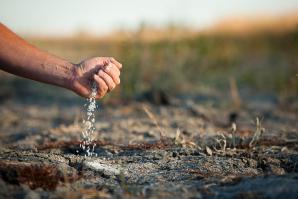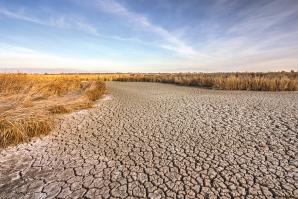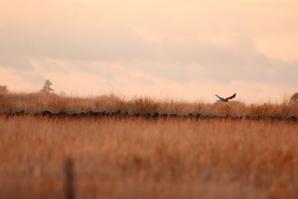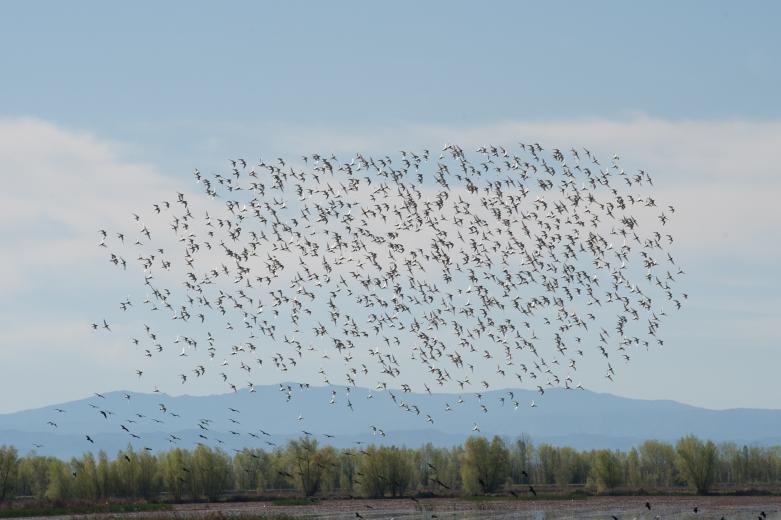Doug Thomas stops his white pickup along the elevated dirt road that carves through the acres of newly planted rice stalks in Wheatland, Calif.
In this scene, replete with a myriad of migratory birds lazily grazing in the green fields, change is soon to come. The landscape, Thomas says, will be transformed into an oasis for waterfowl and shorebirds that will find a man-made wetlands to call home on their annual migration this fall.
BirdReturns, a program started by the Nature Conservancy in 2013, is paying farmers to flood their fields to create essential wetland areas meant to give migrating shorebirds the rest and sustenance needed to complete their trip from the Arctic Circle to South America and back. But with the state facing one of the worst droughts in its history, it is uncertain how much habitat – if any – rice farmers will be able to provide this year.
Thomas, manager at Rue and Forsman Ranch, Inc., says the flooded rice fields provide the same ecological services that wetlands did in California 150-200 years ago. In the last 150 years, more than 95 percent of the once-thriving wetlands were drained, developed and dried out for flood control, housing and farmland, leaving few places for birds to refuel.
The Central Valley is the biggest pit stop for birds along the avian superhighway known as the Pacific Flyway, the route migratory birds on the West Coast travel as they make their fall and spring migrations. These habitats, “are absolutely critical,” says Thomas.
“We set the dinner table for them,” he says. “It’s hard to fly from here to Alaska or the Arctic Circle to breed if you don’t have any fuel for the trip, and we’re where they’re stopping to get that fuel.”
The Nature Conservancy’s aim is to boost shorebird populations in the Central Valley. They pay rice farmers to keep their fields flooded past January, when they would typically drain, and through March and April, when shorebirds are still present, says Sandi Matsumoto, The Nature Conservancy’s Migratory Birds Initiative Senior Project Director.
Farmers flood their fields after harvest from September to January as a means to break down the leftover dry straw material. As a result, plenty of wetland habitat exists in the valley during the fall and winter months when waterfowl – ducks and geese – pass through the farmlands.
While the natural rice growing cycle supports waterfowl, the program aims to assist shorebirds – American avocets, greater yellowlegs, black-necked stilts – which generally pass through the valley after the fields are drained and have the greatest need for these “pop-up” habitats.
Bird watchers contribute “citizen data” by logging where birds are present via a mobile phone application, eBird. This information, coupled with satellite imaging, enables the Conservancy to identify where the greatest need is for the shorebird habitat. Farmers then draw up bids based on what it would cost them to keep the fields flooded longer, and the Conservancy reimburses them for their costs – water purchases, field upkeep and labor.
“The goal is to be as responsive as possible, to create the most amount of habitat at the least cost both to the farmers and to us,” Matsumoto says.
Flowing 20 miles south from the Yuba River, the South Yuba Canal feeds the region’s irrigation needs. Thomas says it provides the water needed for flooding throughout the year.
This year’s drought, however, may mean there will be little to no water from the canal available for any post-harvest flooding whatsoever.
The deficiency would force farmers to use more expensive groundwater for flooding, making it too expensive to participate in the program. With farmers struggling to simply to sustain their normal production cycle, the birds run the risk of falling by the wayside.
“I definitely have high hopes that we will have some sort of (water) allocation to be involved,” says Amelia Harter, owner of Amelia Harter Farming that contributed 175 acres to the BirdReturns program last year.
However, Harter says that without district water, it simply would not be viable to flood and sustain the same number of acres – if any at all — this time around.
“I’m not sure how attractive of an environment I’m going to be able to provide for the program,” she says.
Water allocations notwithstanding, there is risk involved participating in the program. It costs to maintain the fields in addition to stalling preparation for the following year’s seedbed by not drying out the fields in January.
“Everything gets delayed a little bit [and] it just puts a gun to your head as to how much you can get done in a day,” Thomas says.
So why take the risk?
“There’s a personal satisfaction in knowing that we’re doing something good for another species,” Thomas says. “And the other part comes down to economics: If we weren’t profitable, then all this would go away.”
Participants know that it has to make business sense.
“(The Conservancy) realizes… they are compensating us for our risk, and they’re sharing that risk with us,” Thomas says.
Farmers are an active part of their environment, both manipulating and reacting to changes in the land. Cultivating natural resources and interacting with the earth produces a point of pride in seeing that environment thrive,and ultimately that is the reward for many participants in the program,
During the spring months when her fields would comprise a barren dirt wasteland, Harter looks out across the expanse and instead sees a marshy oasis teeming with life. Mallards congregate by the hundreds, lazily picking at the wet straw beneath the shallow water. Small sandpipers busily dart about the muddy expanse, furiously pecking at the dirt with their skinny beaks in a ceaseless search for worms and other invertebrate delicacies. An airborne flock of plover seems to shimmer in the sky as the birds dip and dive in unison.
“I live right next to my fields,” Harter says. “So being able to walk outside and see this habitat, see the birds firsthand, and to have that experience on a daily basis typically during a time where I wouldn’t at all is extremely rewarding.”
Sick of missing out? Sign up for our weekly newsletter highlighting our most popular content!
Recommended For You

Got Storage?
California can't conserve its way out of a drought
Years of drought have baked away some of the divisions inside California’s Capitol, drawing opposing parties together in an effort to find solutions to the state’s ongoing water storage and conveyance problems.

Of Rice and Men
On the Cover: Parched by years of drought, thousands of California’s rice fields lie barren
In the Sacramento Valley, where 97 percent of the state’s rice crop is grown, family farmers have been forced to fallow cropland they have worked for generations. The economic hit has been hard and true, affecting not just farmers, but seed distributors, equipment dealers and anyone else with a thumb in the rice business. The drought could cost Central Valley farmers and communities $1.7 billion this year and may lead to more than 14,500 layoffs.

Dry Times
New water storage alone won't solve California's drought
California is in the third driest year in more than 100 years of record. Farmers throughout the state are seeing their water use curtailed, some communities are rationing water, and fish and wildlife populations are threatened. California needs additional storage capacity to weather such droughts, and it’s groundwater storage — not surface storage — that will have the greatest impact. Still, storage alone won’t be enough.

Call of the Wild
A long-awaited conservation plan in the south county
South of Mather Airport is a grassy field popular with nature lovers and school field trips, particularly in the spring when the vernal pools are in bloom.





